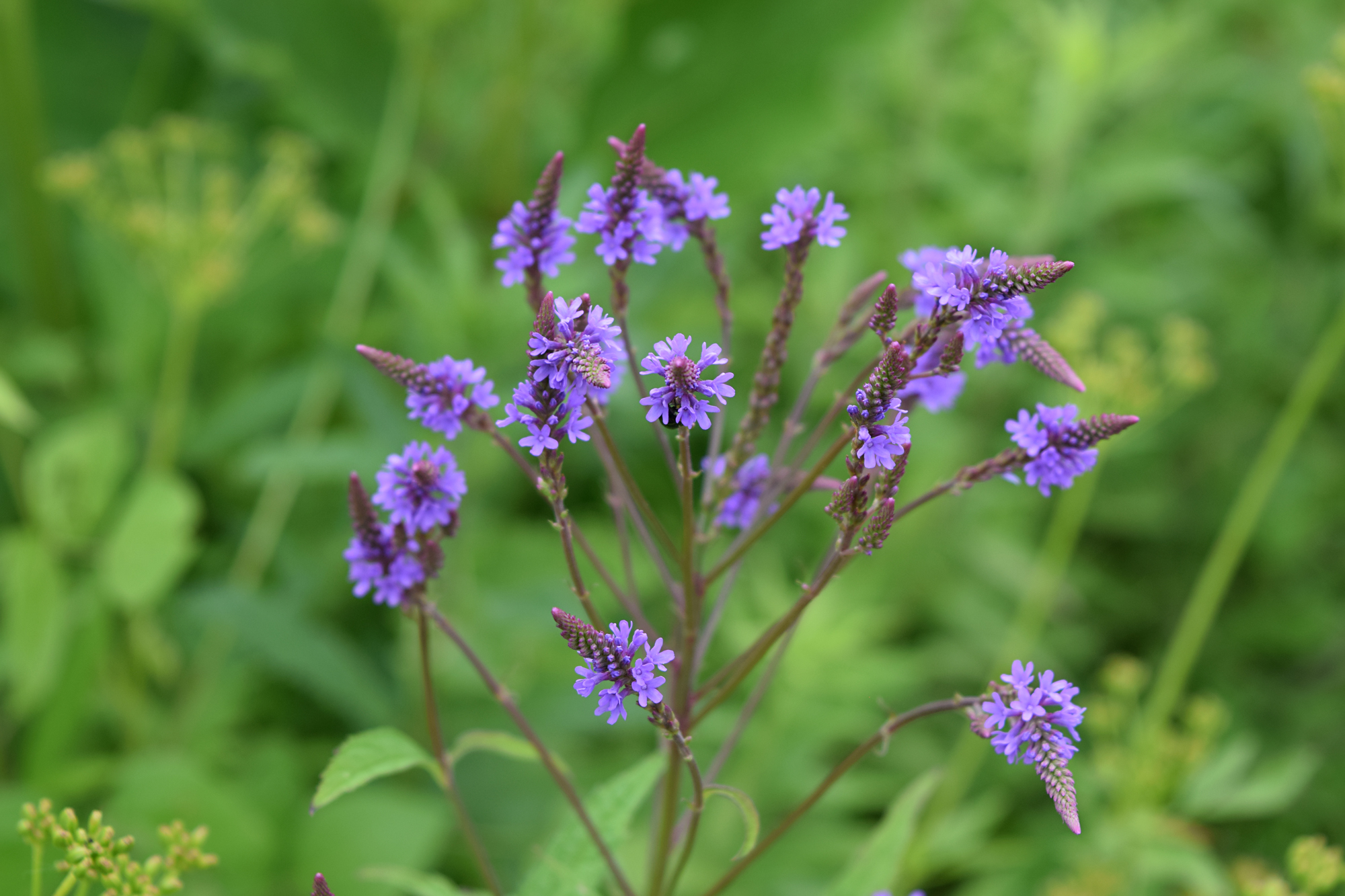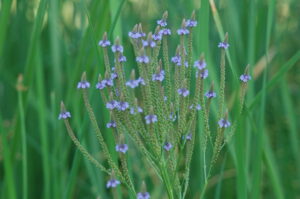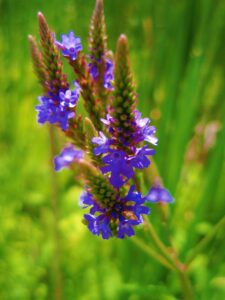Blue Vervain
Overview
Blue Vervain (Verbena hastata) is a perennial plant esteemed for its calming effects. Native to North America, it flourishes in moist environments and is known for its slender, erect stems and deep purple flowers. Traditionally, it has been utilized to ease anxiety and support relaxation, though its medicinal benefits extend to a variety of potential applications. Despite a lack of scientific evidence, Blue Vervain continues to be valued for its traditional uses and gentle impact on the nervous system.
Common name(s): Common names include Swamp Verbena, Wild Hyssop, and Simpler's Joy.
Scientific name: Verbena hastata

Characteristics
Known for its stiffly erect stems, long opposite leaves with serrated margins, and clusters of small purple flowers.
Region
Native to North America, typically found in moist meadows and along streams.
Natural Habitat
Found in a variety of habitats including moist meadows and along streams.
Cultivation
Thrives in full sun to partial shade, prefers moist to wet soil, and tolerates a wide range of soil types but prefers rich loam.
Traditional Usage
Blue Vervain has a storied presence in herbal medicine and has been celebrated for its array of traditional uses. People have turned to this herb for its sedative qualities, using it to encourage a sense of tranquility and to combat anxiety.
Here is a list of its traditional uses:
- As a sedative to ease stress and anxiety.
- To soothe the nervous system, offering relief from symptoms tied to nervous conditions.
- Utilized for its potential nervine properties, which can help calm nerve-related ailments.
- Employed as a diaphoretic, helping to promote sweating and natural detoxification.
- Used for its antispasmodic qualities, possibly aiding in the relief of muscle spasms and cramps.
- Acting as a mild astringent, which may be beneficial for the skin and overall digestive health.
It’s important to remember that while these uses stem from traditional knowledge, consulting with a healthcare provider is advisable before using Blue Vervain, especially when considering it for medicinal purposes4.
Historical Usage
Used by Native American tribes for medicinal purposes and by European herbalists post-colonization.
Common Usage
Currently used for relaxation, inflammation reduction, and digestive system support.
Effects
Blue Vervain is renowned for its calming effects, making it a notable herb for those seeking natural ways to soothe their nervous system. Below are the benefits this herb is traditionally associated with:
- A soothing influence on the nervous system, helping to reduce anxiety and stress.
- Supportive of relaxation, which can ease tension and promote a sense of calm.
- Potentially beneficial for the digestive system, helping to manage inflammation and irritation.
- May act as a diaphoretic, supporting the body’s natural temperature regulation.
- Antispasmodic properties suggest it might help alleviate cramps and muscle spasms.
- Contains mild astringent actions, which could assist in various bodily functions.
Due to its variety of medicinal properties, Blue Vervain has been a staple in traditional herbal medicine. Among the active components contributing to these properties are the iridoids, albeit not fully characterized yet. While many individuals report positive experiences, it’s important to use Blue Vervain with care and ideally, under professional guidance—especially regarding the appropriate dosage to ensure safety4.

Blue vervain is celebrated for its tranquilizing impact on the nervous system, offering a natural path to relaxation and serenity.
Effects when smoking
While Blue Vervain has traditionally been utilized for its calming properties, smoking the herb introduces a slightly different array of effects:
- May induce a calming sensation that soothes the nervous system.
- Users could experience a mild euphoria which is typically associated with the herb’s sedative qualities.
- Can potentially aid in relaxation and stress relief amid a hectic lifestyle.
- Smoking Blue Vervain is not the traditionally recommended administration for medicinal purposes.
However, there are important considerations before deciding to smoke Blue Vervain:
- Consult a healthcare provider or trained herbalist, as self-medication can lead to unintended effects.
- Recognize that the effects can vary from person to person, and what works for one may not work for others.
- Be aware of potential risks, particularly for individuals with specific health conditions or who are pregnant or breastfeeding.
Although not commonly recommended, those choosing to smoke Blue Vervain should do so thoughtfully, informed by the lack of standard dosage guidelines and understanding the limited scientific research on its smoked effects4.
Flavor Profile
Somewhat bitter taste.
Edible Parts
This plant is not known to be edible.
Effects when Smoked
Smoking produces a calming and mildly euphoric effect.
User Experiences
User experiences with Blue Vervain typically include reports of improved mood and reduced anxiety, as well as other diverse health benefits, although such accounts are anecdotal and not scientifically verified.
Medicinal Benefits
Blue Vervain has a storied past rooted in a multitude of medicinal properties. This herb, valued for its therapeutic potential, could offer several health benefits:
- Nervine qualities that may help in reducing anxiety and stress, creating a sense of calm.
- Diaphoretic action, which potentially aids in fever reduction by promoting sweating.
- Antispasmodic properties to alleviate muscle cramps or spasms4.
- Mild astringent effects for minor skin irritations or wounds.
- Support for the digestive system, including easing symptoms of indigestion or bloating.
While these benefits suggest a variety of uses, it is crucial to consult healthcare providers before integrating Blue Vervain into your regimen, particularly for individuals with pre-existing medical conditions or those on medication4.
Safe and responsible use of this herb reflects its respect in herbal traditions and the potential it holds for natural wellness.
History and Folklore
Blue Vervain has been traditionally valued by Native American tribes for its medicinal purposes. Embraced by European herbalists following the colonization of North America, it became known for promoting relaxation and alleviating anxiety, earning it the nickname “simpler’s joy”. This herb’s sedative properties were often employed to soothe nerves and symptoms of various nervous conditions. With a history rooted in natural remedies, Blue Vervain has been a go-to herb for those seeking therapeutic botanicals.

Blue Vervain, cherished by Native Americans and European herbalists alike, is revered for its calming effects and history as a natural sedative remedy.
Side Effects and Contraindications
When using Blue Vervain, it’s important to be aware of potential side effects and contraindications. While generally considered safe, pregnant or breastfeeding women should avoid this herb due to insufficient safety data4. Moreover, individuals with pre-existing medical conditions, or those on certain medications, should exercise caution.
Though side effects are uncommon, some individuals may experience gastrointestinal discomfort or allergic reactions. Because Blue Vervain has sedative properties, it could potentially affect reaction times; thus, it’s advisable not to use it before driving or operating heavy machinery.
If you’re considering Blue Vervain for medicinal use, consult a healthcare provider or trained herbalist to tailor advice to your specific health situation.
Remember, self-medication can be risky—professional guidance is key to ensure safety and efficacy.
Legal Status
References
1. Blue vervain | The Morton Arboretum, https://mortonarb.org/plant-and-protect/trees-and-plants/blue-vervain/
2. Verbena hastata – Wikipedia, https://en.wikipedia.org/wiki/Verbena_hastata
3. Verbena litoralis (blue vervain) | CABI Compendium, https://www.cabidigitallibrary.org/doi/10.1079/cabicompendium.117794
4. Blue Vervain: Benefits, Uses, & Side Effects | Organic Facts, https://www.organicfacts.net/health-benefits/herbs-and-spices/blue-vervain.html
Image Credit: pchgorman Attribution-NonCommercial-ShareAlike License
Image Credit: Men In Black Attribution-NonCommercial License
Image Credit: dianecordell Attribution-NonCommercial-NoDerivs License
Nicolas Duval
Nicolas is a passionate advocate for nature and the art of wildcrafting. His dedication shines through in Wildcraftia, a website he meticulously crafted to serve as a haven for nature enthusiasts worldwide. Driven by a deep appreciation for nature’s connection to humanity, Nicolas embarked on his journey in 2011 with SmokableHerbs, a platform showcasing his love for nature’s bounty. Building upon this foundation, he established Smokably, a thriving online store offering premium herbs and blends to a global audience.
